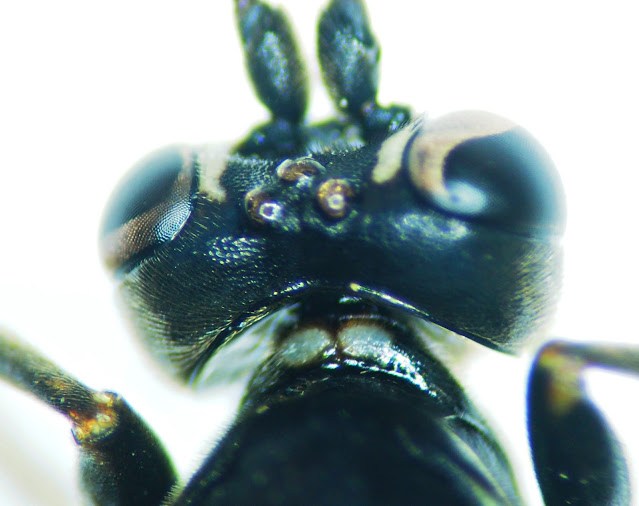I'd never tried yoga until yesterday. But, seeing as younger daughter is now a qualified instructor and at home, and finding that putting my socks on can be difficult, painful, or at least a bit of an effort, I gave it a try. I found out interesting things about myself, that my right arm is a lot less flexible than my left, for example. Younger daughter guarantees better flexibility and balance if I persevere, perhaps 30 minutes, three times a week will be enough to achieve and maintain that. It would be very nice to be able to put my socks on with ease. And no, there isn't a photo and there won't be one either.
There are Arctic Terns with chicks at Skiba Geo, how long they survive is a question. Just 15 pairs, there used to be many more than that.
 |
Arctic Tern and chick.
|
Very few Bonxies to bother them, an estimate of maybe 75% loss since pre-bird flu seems about right talking to other local birders and skua studyers. However, there are other predators, Great Black-backed Gulls and Hoodies to name but two.
This Hoodie and it's sibling were having a bathe not far from the tern colony.
 |
Hoodie post bathe.
|
I've been looking at sawfly larvae a bit, as I keep bumping into them. As well as the millions of Rose Slugs (Endelomyia aethiops) attacking the roses on the front of our house, I've found a possible Cladius crassicornis in Rendall, and new for Orkney was Monsoma pulveratum in South Ronaldsay on Alder, and Dolerus aericeps at Stromness Reservoir, I think second county record - this last three adult females. Also, various unidentified adults of Dolerus and Tenthredo arcuata agg. They're attractive insects and despite its shortcomings (like needing the microscope to look at the illustrations of pinned specimens, they are tiny) the Sawflies of Europe book I received as a retirement present from work is proving very useful.
 |
| Endelomyia aethiops |
 |
| Monsoma pulveratum |
 |
| Cladius crassicornis |
 |
| Endelomyia aethiops |
The Dolerus aericeps were found during the Orkney Field Club bioblitz at Stromness Reservoir. I stayed near the parking area and did a bit of sweep netting and water trapping.
 |
Saw sheath, the way the hairs are arranged nails the ID.
|
 |
| Dolerus aericeps |
 |
Dolerus sp (should have taken the specimen).
|
 |
Tenthredo arcuata agg (not checked it though), in the garden.
|
 |
Euura ferruginea, near Stromness Reservoir.
|
Thanks to JS for confirming IDs and identifying the ones I couldn't do.
The Stromness bioblitz was fun and produced a few ticks, including Dolerus aericeps. So far I've a new weevil, with another to look at and a new mirid, which weirdly I found again the following day in the garden. I'm working on one Ichneumon, but have a couple of others to look at as well.
 |
Micrelus ericae.
|
 |
Leptopterna dolabrata.
|
And here it is in the garden.
 |
Leptopterna dolabrata.
|
Key identification feature, antenna segment 2 is significantly longer than segments 3+4.
The ID process will take a while.
The other exciting event has been a notable migrant moth arrival. First thing was a posting of an identification question on the local FB Group, one of those spotty Yponomeuta's. I've been told that four of these are pretty much inseperable and only Cherry Ermine Y. evonymella is straightforward doable. A little research and asking questions online and it appears that Y. rorrella is also identifiable. I might make a brief page re this. Anyway, to cut to the chase there's been a large immigration event, 150 caught at Cley on 09/07/2023, six in Shetland, and a few scattered across Orkney, including ten in the garden here. This is a new species for Orkney. Many thanks to many folk for commenting on the pix I put online and giving their opinion, especially to NV.
 |
Yponomeuta rorrella, Willow Ermine.
|
For various reasons, which I may write about shortly, I've been re-reading Ian Lorimer's The Lepidoptera of the Orkney Islands and the supplement published after Ian's death, Unfinished Business. With a much better understanding of the Lepidopteran fauna of the islands now, than when I first read the books, they have become a fascinating insight into the changes that have occurred since the original publications in 1983 and 1998.
 |
Back cover of Unfinished Business.
|
Apparently, despite rather debilitating arthritis Ian "continued to work traps in his fairly large garden until the day of his death". (Eric W. Classey - Unfinished Business).



























































